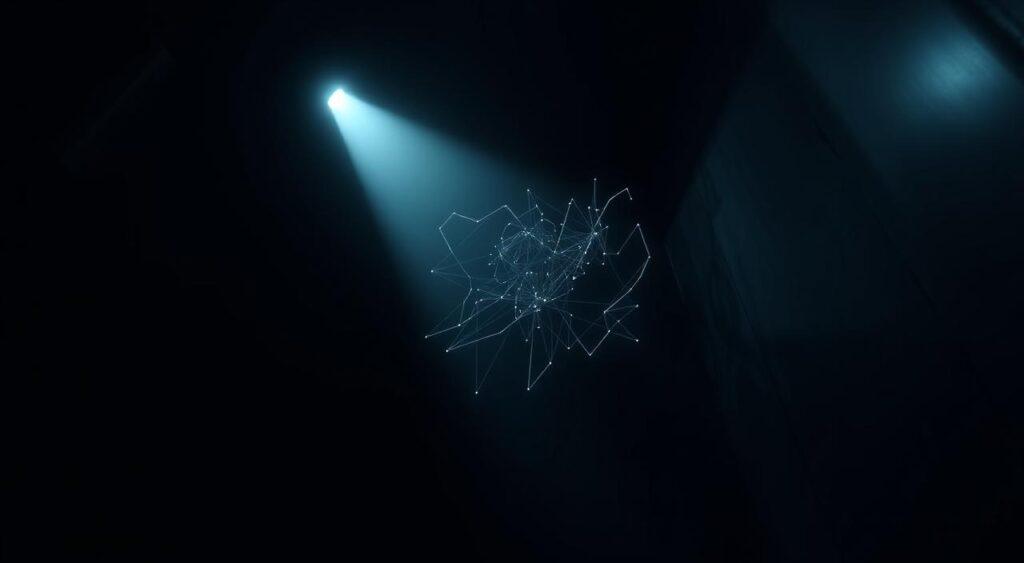Imagine steering a ship through thick fog with no compass or charts. You know storms exist, but hidden dangers lurk beneath the waves—risks you can’t predict because you don’t even know they’re there. This is the heart of the unknown unknowns mental model, a framework that helps us navigate gaps in our knowledge.
Former U.S. Secretary of Defense Donald Rumsfeld famously categorized knowledge into three types: “known knowns,” “known unknowns,” and “unknown unknowns.” The last group—the blind spots we can’t see—is where even experts stumble. Isaac Newton once said, “What we know is a drop; what we don’t know is an ocean,” highlighting how much lies beyond our awareness.
In business, this model explains why plans fail despite careful preparation. A company might anticipate supply chain delays (a “known unknown”) but miss a sudden market shift caused by new technology (an “unknown unknown”). By understanding these layers, we can build strategies that account for the unpredictable.
Key Takeaways
- The model divides knowledge into three categories: known facts, anticipated gaps, and invisible risks.
- Historical figures like Newton and Rumsfeld shaped how we view unpredictable challenges.
- Businesses often overlook hidden threats because they focus only on visible problems.
- Accepting uncertainty helps create flexible plans for an ever-changing world.
- Real-world examples show how unknown unknowns impact decisions in every field.
Understanding the Four Quadrants of Knowledge

Think of knowledge as a puzzle where some pieces are missing—and you don’t even know how many are gone. This idea aligns with the Johari Window, a communication tool that splits awareness into four areas: what you know, what others know, what you don’t know, and what nobody knows. Let’s break down these quadrants to see how they shape decisions.
Defining Known Knowns and Known Unknowns
Known knowns, which people also know are facts you’re sure about, like your team’s budget or a recipe’s steps. They’re reliable but limited. Known unknowns, however, are models of gaps you recognize.
Imagine a baker who knows their oven’s quirks but can’t predict a flour shortage. These are questions you can plan for, like researching suppliers or testing backup ingredients.
Exploring the Realm of Unknown Unknowns
Here’s where things get tricky. These are risks you can’t see coming, like a tech company missing a breakthrough in AI or a general unprepared for a new type of warfare.
Donald Rumsfeld once called these the “hardest to tackle” because they’re invisible until they strike. For example, Blockbuster knew about streaming services but underestimated how fast they’d change movie rentals.
Why does this matter? By mapping these quadrants, you build plans that adapt. A farmer might rotate crops (known knowns), watch weather patterns (known unknowns), but still face a pest no one predicted.
The goal isn’t to eliminate surprises—it’s to stay curious and ready.
Exploring Blind Spots and Unseen Risks

Imagine driving on a familiar road, only to hit a pothole you never noticed. That’s how blind spots work—hidden gaps in our awareness that trip up even seasoned professionals.
These overlooked dangers often stem from biases or incomplete knowledge, quietly shaping the way decisions are made until problems arise in the minds of people.
Unknown Unknowns Mental Model: Hidden Information and Biases
Ever wonder why smart teams miss obvious risks? It’s not always lack of effort. Sometimes, unknown knowns—information we have but ignore—cloud judgment. A military strategist might dismiss civilian intel because “it doesn’t fit the pattern,” or a company overlooks customer complaints while rushing a product launch.
Donald Rumsfeld, who famously highlighted the challenge of “unknown unknowns,” stressed that “the absence of evidence isn’t evidence of absence.”
Business history is full of these moments. Brands like Kodak knew what they knew about film but missed the digital revolution. How do you spot such traps? Start by questioning assumptions. Ask: “What if we’re wrong?” Tools like blind spot analysis reveal patterns in past oversights, while diverse teams challenge echo chambers.
Finally, build habits that surface hidden risks. Schedule “what’s missing?” discussions before big decisions. Encourage dissent—it’s not negativity, it’s clarity. As shown in real-world strategies, acknowledging blind spots turns uncertainty into a planning superpower.
Leveraging The Unknown Unknowns Mental Model for Effective Planning

Imagine planting a garden with perfect soil and sunlight—only to find pests devouring your crops. You prepared for weather shifts (a known unknown) but missed the invisible threat. This is why smart planners bake flexibility into every strategy. Let’s explore how to turn uncertainty into an advantage.
Strategies for Budgeting and Building in Slack
Ever noticed how highways have emergency lanes? Budgets need similar buffers. A tech startup might allocate 20% extra funds for sudden server costs or shifting customer demands. Slack isn’t waste—it’s insurance. For example, a construction firm faced cement shortages but stayed on track because they’d reserved funds for material delays.
Running Pre-Mortems to Anticipate Unforeseen Failures
What if your project fails? Ask that before launching. Teams at a healthcare company once role-played a scenario where new regulations halted their product. They discovered overlooked compliance risks and redesigned their approach. Similarly, the U.S. Army uses “Red Team” exercises to challenge battle plans, asking, “What could we have missed?”
These methods don’t predict every problem—they build muscles for adaptation. Like a chef tasting dishes mid-prep, staying curious helps you adjust before crises strike. How will your next plan handle the unpredictable?
Implementing Risk Mitigation Strategies in Business

Picture a trapeze artist working without a safety net—one misstep could spell disaster. Businesses face similar risks daily, but smart planning helps you know how to turn potential falls into recoverable stumbles.
Let’s explore how teams build resilience through diversification and a lot of relentless curiosity, keeping knowns in mind.
Diversifying Options to Cushion the Impact
What happens when your primary supplier shuts down? Ecommerce giants like Amazon avoid chaos by partnering with multiple vendors. A 2022 study showed companies using 3+ suppliers recovered 58% faster during supply chain crises. Consider these approaches:
| Strategy | Outcome | Example |
|---|---|---|
| Multi-channel sales | 40% revenue stability | Shopify stores using Instagram + website |
| Backup payment systems | 99.9% uptime | Stripe + PayPal redundancy |
| Cross-trained teams | 67% faster pivots | Zappos客服 handling inventory + sales |
Staying Curious and Challenging Assumptions
Why did Blockbuster fail while Netflix thrived? One team stopped questioning; the other made “what if?” their mantra. Product teams at Apple hold weekly “assumption audits” where junior staff critique senior plans.
This flips traditional hierarchies and surfaces hidden risks.
Try this: Next meeting, ask your team, “What’s one thing we’re all ignoring?” You might uncover blind spots like a SaaS company did when they discovered users wanted offline features—a need their analytics never showed.
By blending backup plans with curious cultures, businesses turn uncertainty into innovation fuel. How many safety nets does your strategy have?
Real-World Applications and Lessons Learned
Picture a pilot navigating through stormy skies, relying on instruments to spot hidden turbulence. Organizations face similar invisible threats daily—but the right tools and information turn chaos into clarity.
To truly know the landscape, it’s essential to identify the unknown knowns and understand the line between what we think we know and the things we overlook. Let’s explore how industries tackle unseen risks through actionable strategies.
Insights from Military, Business, and Technology
The U.S. Navy’s “pre-mortem” drills saved lives during a 2020 Pacific exercise. By simulating equipment failures beforehand, crews identified 12 hidden flaws in communication systems. This practice, rooted in acknowledging ignorance, transformed potential disasters into training opportunities.
Businesses also thrive by embracing uncertainty. When COVID-19 disrupted supply chains, Toyota leaned on real-time information sharing with suppliers. Their “resilience dashboard” flagged shortages 48 hours faster than competitors, turning a crisis into a learning opportunity through iterative updates.
Tech giants like SpaceX use agile prototyping to outmaneuver unknowns. Early Starlink satellites faced orbital challenges, but rapid testing cycles uncovered solutions. “Failure isn’t the end—it’s a data point,” said a lead engineer. This mindset cut development time by 30%.
| Industry | Tool | Outcome |
|---|---|---|
| Military | Pre-mortem simulations | 12+ risks mitigated |
| Business | Real-time dashboards | 48-hour response boost |
| Technology | Agile prototyping | 30% faster innovation |
What’s the key takeaway? Admitting ignorance fuels progress. Teams that ask “What’s missing?” build systems ready for tomorrow’s surprises—one point of data at a time.
Conclusion
Have you ever packed for a trip only to realize you forgot something crucial? Life’s unpredictable situations work the same way—no matter how prepared we are, gaps in awareness remain.
The key lies in building plans that bend rather than break. History shows this: from Newton’s humility about unseen forces to modern firms using real-time data, progress thrives when we accept our blind spots.
Think of your thoughts like a toolbox. You’ll face challenges no manual covers—a supplier collapse, a tech shift, or personal curveballs. That’s why diverse teams and flexible budgets matter. Ask yourself: “What assumptions am I making today?” or “Where could my experience mislead me?”
True awareness isn’t about knowing everything—it’s staying curious. Like a hiker checking the weather mid-trail, pause often to reassess. Build slack into timelines, welcome dissenting voices, and treat surprises as teachers. Over years, this mindset becomes your compass through foggy situations.
What difference could this make for you? Whether navigating business risks or personal problems, embracing uncertainty turns hidden threats into growth fuel. Ready to walk that path?


